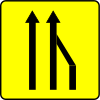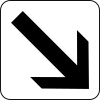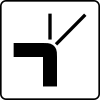This article has multiple issues. Please help improve it or discuss these issues on the talk page. (Learn how and when to remove these messages)
|

Road signs in France refer to all conventional signals installed on French roads and intended to ensure the safety of road users, either by informing them of the dangers and regulations relating to traffic as well as elements useful for decision-making, or by indicating to them the landmarks and equipment useful for their travel on the national territory. They generally largely follow the general European conventions concerning the use of shape and color to indicate their function. France is a signatory to the 1968 Vienna Convention on Road Signs and Signals. France signed the Vienna Convention on Road Signs and Signals on 8 November 1968 and ratified it on 9 December 1971.
These road signs can also be found in some overseas territories of France.
History
The first road signs with modern symbols were created in France in 1902 by the Automobile Club of France, which had been founded in 1895. When cars started appearing in France in the 1900s, there were signs for motorists and cyclists with the words "Moderate Speed" or "Slow Down". On 11 October 1909, the first attempt at international unification of road signs was made in Geneva. Four round-shaped obstacle signs were adopted: "break", "Z-bends", "Level crossing with barrier" and "X-crossing".
In 1926, the four danger signs created and used since 1909 were definitively changed from the disc shape to the triangle shape still in use today. Unguarded level crossings were added, and in 1928, at Switzerland's request, one-way, direction, parking and no parking signs were adopted. In 1931, France signed the Geneva Convention concerning the unification of road signs and signals.
On 15 July 1942, during the occupation of French territories by Nazi Germany in World War II, a decree was signed amending the traffic rules: a sheet was to be placed around danger signs and the colour of the vignettes (previously dark blue) was to become black, as was the German custom. However, these changes were probably not implemented.
After the end of the war, a general instruction dated 1 August 1946 on road signs was published. This was the first document to regulate in detail all applications of road signs. Colours were standardised. The shape of some signs was changed, such as danger signs, the corners of which were now rounded. Some graphic elements were changed. New signs appeared: height limits, double speed limits for buses and cars, prohibition of lorries, thawing barriers, etc.
Warning signs
- Warning signs
-
 Bend to right
Bend to right
-
 Bend to left
Bend to left
-
 Double bend first to right
Double bend first to right
-
 Double bend first to left
Double bend first to left
-
 Collapse or bump
Collapse or bump
-
 Speed bump
Speed bump
-
 Road narrows
Road narrows
-
 Road narrows on right
Road narrows on right
-
 Road narrows on left
Road narrows on left
-
 Slippery road
Slippery road
-
 Opening bridge ahead
Opening bridge ahead
-
 Level crossing with gates
Level crossing with gates
-
 Level crossing without gates
Level crossing without gates
-
 Buses crossing ahead
Buses crossing ahead
-
 Trams crossing ahead
Trams crossing ahead
-
 Children crossing
Children crossing
-
 Pedestrian crossing ahead
Pedestrian crossing ahead
-
 Other danger
Other danger
-
 Cattle
Cattle
-
 Sheep
Sheep
-
 Wild animals
Wild animals
-
 Equestrians
Equestrians
-
 Steep hill downwards
Steep hill downwards
-
 Traffic light
Traffic light
-
 Two-way traffic ahead
Two-way traffic ahead
-
 Risk of rockfall
Risk of rockfall
-
 Quayside or river bank
Quayside or river bank
-
 Cyclists
Cyclists
-
 Low-flying aircraft
Low-flying aircraft
-
 Side winds
Side winds
Priority signs
- Priority signs
-
 Crossroads with right of way from the right
Crossroads with right of way from the right
-
 Crossroads with priority
Crossroads with priority
-
 Give way
Give way
-
 Give Way sign 150 metres ahead
Give Way sign 150 metres ahead
-
 Stop, give way
Stop, give way
-
 Stop sign 150 metres ahead
Stop sign 150 metres ahead
-
 Priority road
Priority road
-
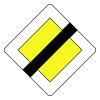 End of priority road
End of priority road
-
 Roundabout ahead
Roundabout ahead
Regulatory signs
- Prohibitory signs
-
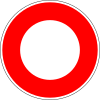 No vehicles
No vehicles
-
 No entry
No entry
-
 No entry
No entry
-
 No left turn
No left turn
-
 No right turn
No right turn
-
 No U-turns
No U-turns
-
 No overtaking
No overtaking
-
 No overtaking by lorries
No overtaking by lorries
-
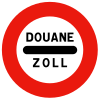 Stop - customs
Stop - customs
-
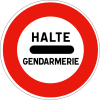 Stop - gendarmerie
Stop - gendarmerie
-
 Stop - police
Stop - police
-
 Stop - toll
Stop - toll
-
 No parking
No parking
-
 Parking restrictions
Parking restrictions
-
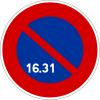 Parking restrictions
Parking restrictions
-
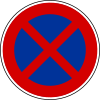 No stopping
No stopping
-
 No motor vehicles except mopeds
No motor vehicles except mopeds
-
 No motor vehicles including mopeds
No motor vehicles including mopeds
-
 No lorries
No lorries
-
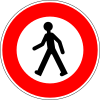 No pedestrians
No pedestrians
-
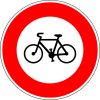 No cycling
No cycling
-
 No horse-drawn vehicles
No horse-drawn vehicles
-
 No tractors
No tractors
-
 No handcarts
No handcarts
-
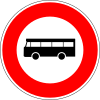 No buses
No buses
-
 No mopeds
No mopeds
-
 No motorcycles
No motorcycles
-
 No vehicles towing caravans
No vehicles towing caravans
-
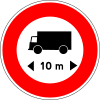 Length limit
Length limit
-
 Width limit
Width limit
-
 Height limit
Height limit
-
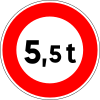 Weight limit
Weight limit
-
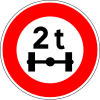 Axle weight limit
Axle weight limit
-
 Speed limit
Speed limit
-
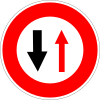 Give priority to oncoming vehicles
Give priority to oncoming vehicles
-
 No sounding of horns
No sounding of horns
-
 No traffic allowed without indicated minimum distance between vehicles
No traffic allowed without indicated minimum distance between vehicles
-
 No vehicles carrying explosives
No vehicles carrying explosives
-
 No vehicles carrying water pollutants
No vehicles carrying water pollutants
-
 No vehicles carrying dangerous goods
No vehicles carrying dangerous goods
-
 Other restrictions
Other restrictions
- Mandatory signs
-
 Turn right
Turn right
-
 Turn left
Turn left
-
 Keep right
Keep right
-
 Keep left
Keep left
-
 Ahead only
Ahead only
-
 Turn right ahead
Turn right ahead
-
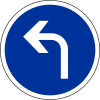 Turn left ahead
Turn left ahead
-
 Go ahead or turn right
Go ahead or turn right
-
 Go ahead or turn left
Go ahead or turn left
-
 Turn left or right
Turn left or right
-
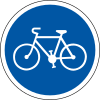 Bicycle lane
Bicycle lane
-
 Pedestrian lane
Pedestrian lane
-
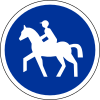 Bridleway
Bridleway
-
 Minimum speed
Minimum speed
-
 Snow chains compulsory
Snow chains compulsory
-
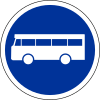 Bus lane
Bus lane
-
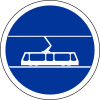 Tram lane
Tram lane
-
 Other obligations
Other obligations
-
 End of bicycle lane
End of bicycle lane
-
 End of pedestrian lane
End of pedestrian lane
-
 End of bridleway
End of bridleway
-
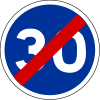 End of minimum speed
End of minimum speed
-
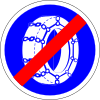 End of snow chains zone
End of snow chains zone
-
 End of bus lane
End of bus lane
-
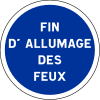 End of other obligations
End of other obligations
- End of restrictions
-
 End of restriction
End of restriction
-
 End of 50 km/h zone
End of 50 km/h zone
-
 End of no overtaking
End of no overtaking
-
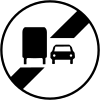 End of no overtaking by lorries
End of no overtaking by lorries
-
 End of no sounding of horns
End of no sounding of horns
-
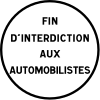 End of other restrictions
End of other restrictions
- Zonal prescription signs
-
 No parking zone
No parking zone
-
 Restricted parking zone
Restricted parking zone
-
 Disc parking zone
Disc parking zone
-
 Meter parking zone
Meter parking zone
-
 Restricted disc parking zone
Restricted disc parking zone
-
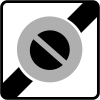 End of a no parking zone
End of a no parking zone
-
 End of a restricted parking zone
End of a restricted parking zone
-
 End of a disc parking zone
End of a disc parking zone
-
 End of a meter parking zone
End of a meter parking zone
-
 End of a restricted disc parking zone
End of a restricted disc parking zone
-
 30 km/h zone
30 km/h zone
-
 End of 30 km/h zone
End of 30 km/h zone
-
 Home Zone (20 km/h speed limit)
Home Zone (20 km/h speed limit)
-
 End of Home Zone
End of Home Zone
-
 Pedestrian precinct
Pedestrian precinct
-
 End of pedestrian precinct
End of pedestrian precinct
-
 Restricted access area
Restricted access area
-
 End of a restricted access area
End of a restricted access area
-
 Zone where winter equipment is compulsory
Zone where winter equipment is compulsory
-
 End of a zone where winter equipment is compulsory
End of a zone where winter equipment is compulsory
Information signs
- Information signs
-
 Parking zone
Parking zone
-
 Disc parking zone
Disc parking zone
-
 Meter parking zone
Meter parking zone
-
 Risk of fire
Risk of fire
-
 Advisory minimum speed
Advisory minimum speed
-
 End of advisory minimum speed
End of advisory minimum speed
-
 Taxi rank
Taxi rank
-
 Bus stop
Bus stop
-
 Breakdown bay
Breakdown bay
-
 Carsharing
Carsharing
-
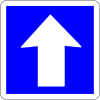 One-way traffic
One-way traffic
-
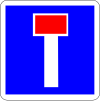 Dead end
Dead end
-
 Dead end (right)
Dead end (right)
-
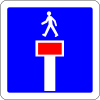 Dead end permeable for pedestrians
Dead end permeable for pedestrians
-
 Dead end permeable for pedestrians and cyclists
Dead end permeable for pedestrians and cyclists
-
 Road use restrictions
Road use restrictions
-
 Road use restrictions
Road use restrictions
-
 Priority over oncoming vehicles
Priority over oncoming vehicles
-
 Pedestrian crossing
Pedestrian crossing
-
 Bus lane crossing
Bus lane crossing
-
 Tram crossing
Tram crossing
-
 Caravan parking restricted
Caravan parking restricted
-
 Lane forbidden for use by lorries
Lane forbidden for use by lorries
-
 Contra-flow cyclists
Contra-flow cyclists
-
 Contra-flow bus lane
Contra-flow bus lane
-
 Slip road to left
Slip road to left
-
 Slip road to right
Slip road to right
-
 Level crossing with gates on side road
Level crossing with gates on side road
-
 Contra-flow cycle lane
Contra-flow cycle lane
-
 Speed limits in France (at entrance to country)
Speed limits in France (at entrance to country)
-
 Speed limits on motorways
Speed limits on motorways
-
 Escape lane on right
Escape lane on right
-
 Escape lane on left
Escape lane on left
-
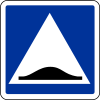 Speed bump
Speed bump
-
 Lanes merge
Lanes merge
-
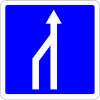 Lanes merge
Lanes merge
-
 Overtaking lanes
Overtaking lanes
-
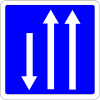 Overtaking lanes
Overtaking lanes
-
 End of overtaking lanes
End of overtaking lanes
-
 Other informations
Other informations
-
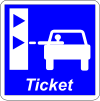 Toll ticket marking point
Toll ticket marking point
-
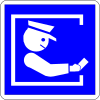 Manned tollbooth
Manned tollbooth
-
 Toll payment by debit or credit card
Toll payment by debit or credit card
-
 Toll payment by cash
Toll payment by cash
-
 Toll payment by subscription
Toll payment by subscription
-
 Expressway (controlled-access highway)
Expressway (controlled-access highway)
-
 End of expressway
End of expressway
-
 Tunnel
Tunnel
-
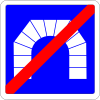 End of tunnel
End of tunnel
-
 Cycle route
Cycle route
-
 End of cycle route
End of cycle route
-
 Pedestrian and cycle route
Pedestrian and cycle route
-
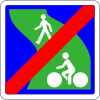 End of pedestrian and cycle route
End of pedestrian and cycle route
-
 Motorway
Motorway
-
 End of motorway
End of motorway
Service signs
- Service signs
-
 First aid
First aid
-
 Emergency telephone
Emergency telephone
-
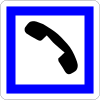 Telephone
Telephone
-
 Information
Information
-
 Tourist information board
Tourist information board
-
 Campsite
Campsite
-
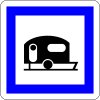 Caravan site
Caravan site
-
 Camping and caravan site
Camping and caravan site
-
 Youth hostel
Youth hostel
-
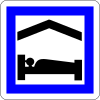 Self-catering accommodation
Self-catering accommodation
-
 Hiking itinerary
Hiking itinerary
-
 Winter sports itinerary
Winter sports itinerary
-
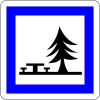 Picnic site
Picnic site
-
 Motorail services
Motorail services
-
 Video-monitored car park
Video-monitored car park
-
 Car ferry
Car ferry
-
 Toilets
Toilets
-
 Services for the disabled
Services for the disabled
-
 Petrol
Petrol
-
 Petrol and liquid petroleum gas
Petrol and liquid petroleum gas
-
 Petrol
Petrol
-
 Petrol and liquid petroleum gas
Petrol and liquid petroleum gas
-
 Petrol and charging station
Petrol and charging station
-
 Petrol, liquid petroleum gas and charging station
Petrol, liquid petroleum gas and charging station
-
 Charging station
Charging station
-
 Charging station and liquid petroleum gas
Charging station and liquid petroleum gas
-
 Restaurant
Restaurant
-
 Hotel
Hotel
-
 Café
Café
-
 Mooring for boats
Mooring for boats
-
 Cable car
Cable car
-
 Chairlift or gondola lift
Chairlift or gondola lift
-
 Viewpoint
Viewpoint
-
 Local radio station
Local radio station
-
 Playground
Playground
-
 Drainage
Drainage
-
 ATM
ATM
-
 Air pressure check
Air pressure check
-
 Recreation area
Recreation area
-
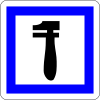 Repairs
Repairs
-
 Fire extinguisher
Fire extinguisher
-
 Emergency exit (right)
Emergency exit (right)
-
 Emergency exit (left)
Emergency exit (left)
-
 Other services
Other services
-
 Eco-tax for trucks
Eco-tax for trucks
-
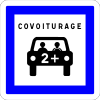 Carpooling
Carpooling
Location signs
Railway signs
- Railway signs
-
 Level crossing without gates (single track) or aircraft crossing area
Level crossing without gates (single track) or aircraft crossing area
-
 Level crossing without gates (several tracks)
Level crossing without gates (several tracks)
-
 Level crossing without gates (single track) or aircraft crossing area
Level crossing without gates (single track) or aircraft crossing area
-
 Level crossing without gates (several tracks)
Level crossing without gates (several tracks)
-
 Level crossing without gates and with a flashing red warning light (single track)
Level crossing without gates and with a flashing red warning light (single track)
-
 Level crossing without gates and with a flashing red warning light (single track)
Level crossing without gates and with a flashing red warning light (single track)
-
 Gates
Gates
-
 Gantry in the presence of high-voltage cables
Gantry in the presence of high-voltage cables
Temporary signs
- Warning signs
-
 Uneven road
Uneven road
-
 Road narrows
Road narrows
-
 Slippery road
Slippery road
-
 Road works
Road works
-
 Other danger
Other danger
-
 Temporary traffic signals
Temporary traffic signals
-
 Loose chippings
Loose chippings
-
 Queues likely
Queues likely
-
 Accident
Accident
-
 Reduced visibility
Reduced visibility
Additional signs
- Vehicle categories
-
 Cars
Cars
-
 Buses
Buses
-
 Motorbikes
Motorbikes
-
 Bicycles
Bicycles
-
 Mopeds
Mopeds
-
 Other category
Other category
-
 Weight
Weight
-
 Lorries
Lorries
-
 Weight of lorries
Weight of lorries
-
 Tractors
Tractors
-
 Vehicles with snow chains
Vehicles with snow chains
-
 Vehicles carrying explosives
Vehicles carrying explosives
-
 Vehicles carrying water polluants
Vehicles carrying water polluants
-
 Vehicles carrying dangerous goods
Vehicles carrying dangerous goods
-
 Disabled
Disabled
-
 Pedestrians
Pedestrians
-
 Length
Length
-
 Axle weight
Axle weight
-
 Horse-drawn vehicles
Horse-drawn vehicles
-
 Handcarts
Handcarts
-
 Width
Width
-
 Height
Height
-
 Trailers
Trailers
-
 Vehicles towing caravans
Vehicles towing caravans
-
 Horses
Horses
-
 Carsharing
Carsharing
- Signs related to parking
-
 Parked vehicles will be towed away
Parked vehicles will be towed away
-
 Parking restrictions
Parking restrictions
-
 Disc parking restrictions
Disc parking restrictions
-
 Parking for disabled only
Parking for disabled only
-
 Parking for electric vehicles only
Parking for electric vehicles only
-
 Parking for carsharing only
Parking for carsharing only
-
 Carpooling
Carpooling
-
 Parking for carpooling only
Parking for carpooling only
- Indication signs
-
 Aircraft crossing
Aircraft crossing
-
 High voltage cables
High voltage cables
-
 Give way
Give way
-
 Speed bump
Speed bump
-
 Emergency phone
Emergency phone
-
 Emergency phone and fire extinguisher
Emergency phone and fire extinguisher
-
 Risk of accident
Risk of accident
-
 Risk of accident
Risk of accident
-
 Reserved lane
Reserved lane
-
 Reserved lanes
Reserved lanes
-
 Noise protection
Noise protection
-
 Except for bicycles
Except for bicycles
-
 Except for bicycles
Except for bicycles
-
 Other indication
Other indication
- Other restrictions signs
-
 Authorised vehicle category
Authorised vehicle category
-
 Time slot
Time slot
-
 Other restrictions in a zone
Other restrictions in a zone
-
 Tunnel category for vehicles carrying dangerous goods
Tunnel category for vehicles carrying dangerous goods
-
 Tunnel category for vehicles carrying dangerous goods (with time restriction)
Tunnel category for vehicles carrying dangerous goods (with time restriction)
-
 Low emission zone
Low emission zone
- Specific signs for bicycles
-
 Bicycles are allowed to cross the red light for turning right
Bicycles are allowed to cross the red light for turning right
-
 Bicycles are allowed to cross the red light for going straight
Bicycles are allowed to cross the red light for going straight
Retired signs
Obsolete signs since 1998
-
 Pedestrian crossing
Pedestrian crossing
-
 Cyclists approaching from the right
Cyclists approaching from the right
-
 Disc parking zone
Disc parking zone
-
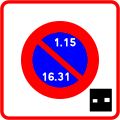 Restricted disc parking zone
Restricted disc parking zone
-
 End of tramway lane
End of tramway lane
-
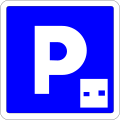 Disc parking
Disc parking
-
 Hospital
Hospital
-
 Priority over oncoming traffic
Priority over oncoming traffic
-
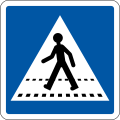 Pedestrian crossing
Pedestrian crossing
-
 Emergency lane (Middle)
Emergency lane (Middle)
Obsolete signs since 1977
-
 Children crossing
Children crossing
-
 Pedestrian crossing
Pedestrian crossing
-
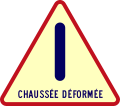 Other danger
Other danger
-
 Cattle
Cattle
-
 Wild animals
Wild animals
-
 Steep hill downwards
Steep hill downwards
-
 Traffic light
Traffic light
-
 Roadworks
Roadworks
-
 No through road
No through road
-
 Campsite
Campsite
-
 Caravan site
Caravan site
-
 Camping and caravan site
Camping and caravan site
-
 Youth hostel
Youth hostel
References
- "Vienna Convention on Road Signs and Signals - unece" (PDF). United Nations Economic Commission for Europe (UNECE). UNITED NATIONS. Retrieved 12 July 2018.
- "United Nations Treaty Collection". treaties.un.org. Retrieved 2023-12-07.
- "Signalisation routière" (in French). CodeFast.fr. Retrieved 16 February 2017.
- "Histoire des inventions. Mais quand sont apparus les premiers panneaux routiers?". www.leprogres.fr (in French). Retrieved 2024-02-20.
- Duhamel, Marina (1994). Un demi-siècle de signalisation routière – Naissance et évolution du panneau de signalisation routière en France (in French). Edts des Presses des Ponts et Chaussées. ISBN 9782859782207.
| Traffic signs | |||||||||||||||
|---|---|---|---|---|---|---|---|---|---|---|---|---|---|---|---|
| Signs |
| ||||||||||||||
| By country |
| ||||||||||||||
| Lights | |||||||||||||||
| Typefaces | |||||||||||||||
| International conventions |
| ||||||||||||||
| National standards | |||||||||||||||
| Comparisons | |||||||||||||||
| Road signs in Europe | |
|---|---|
| Sovereign states |
|
| States with limited recognition | |
| Dependencies and other entities | |



